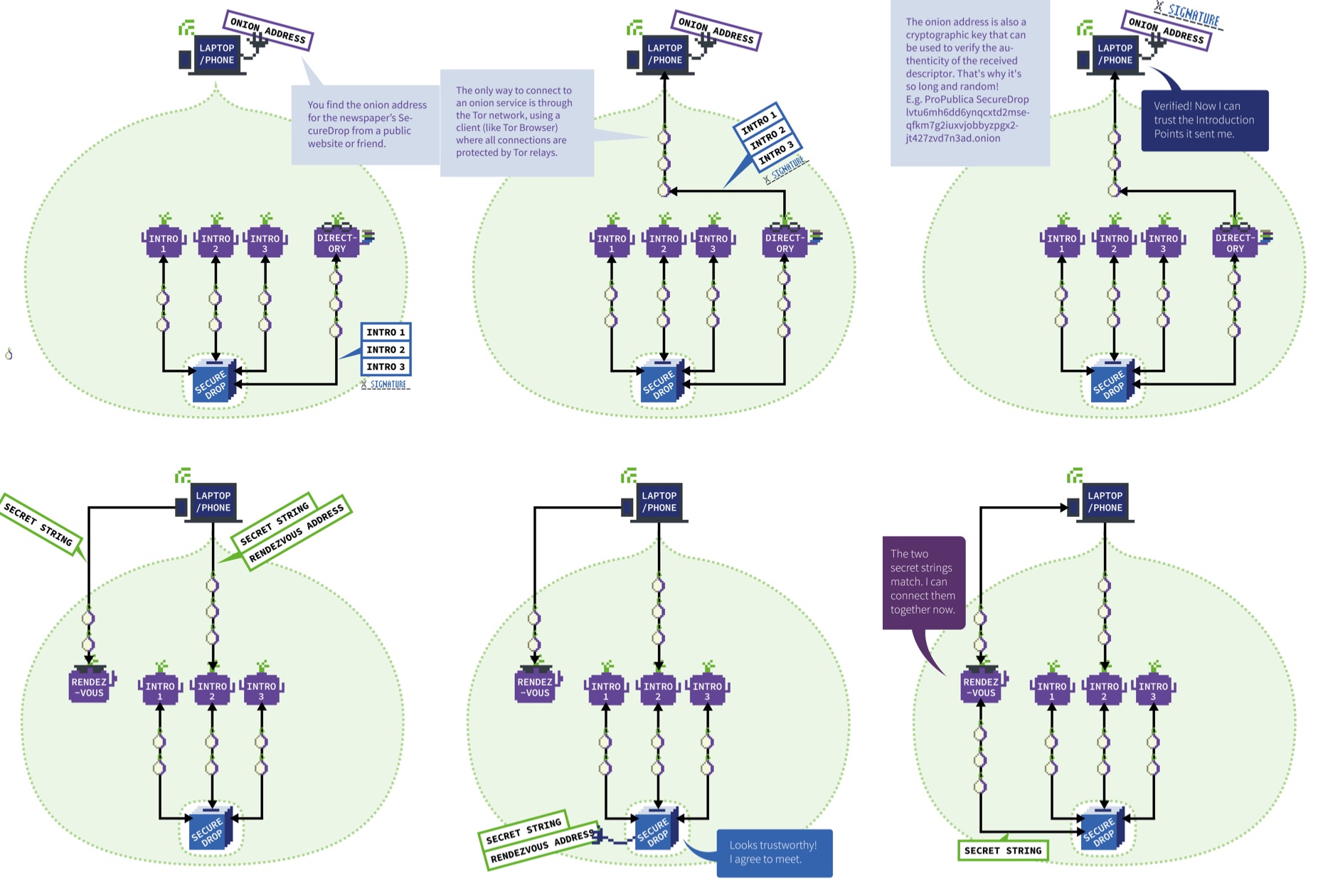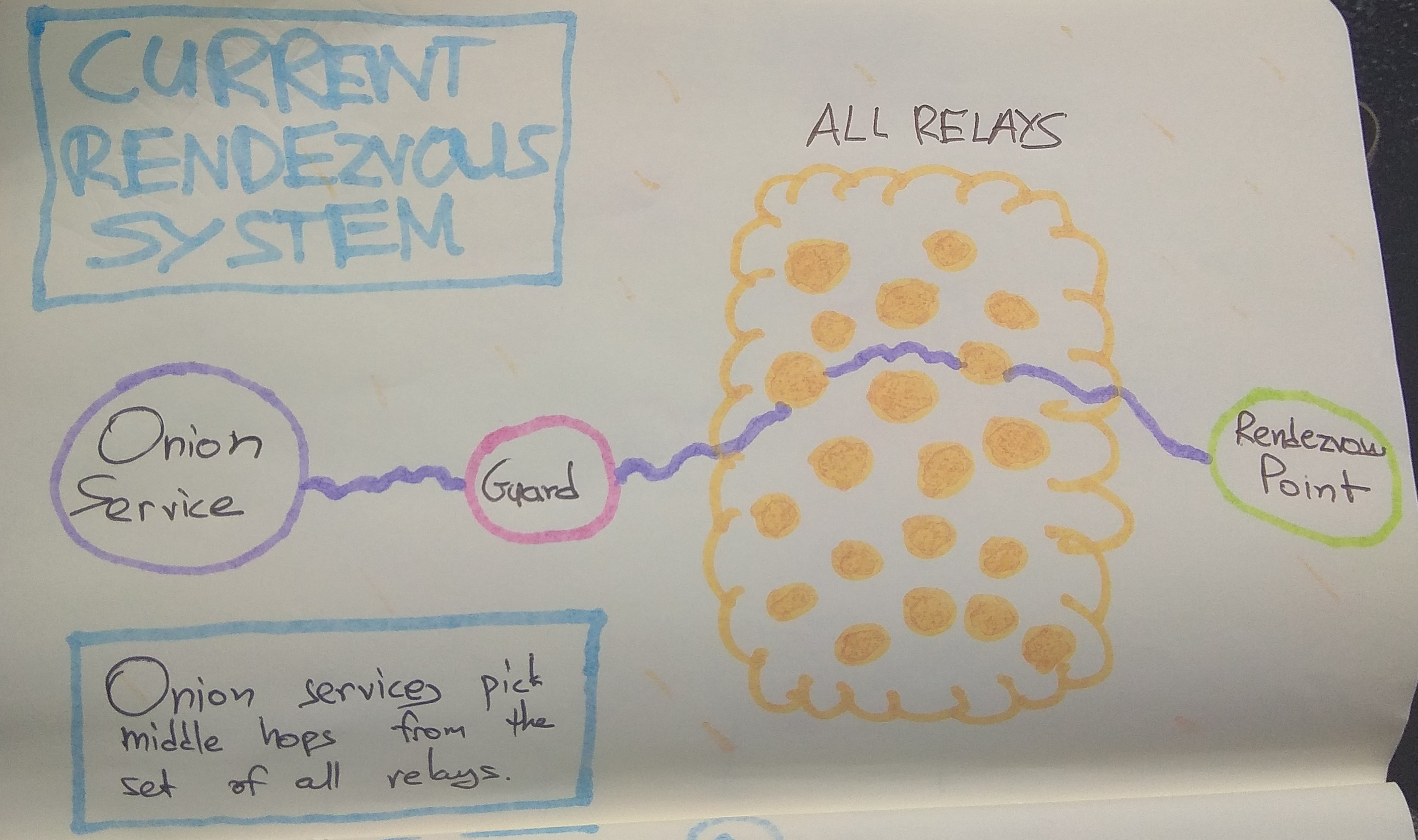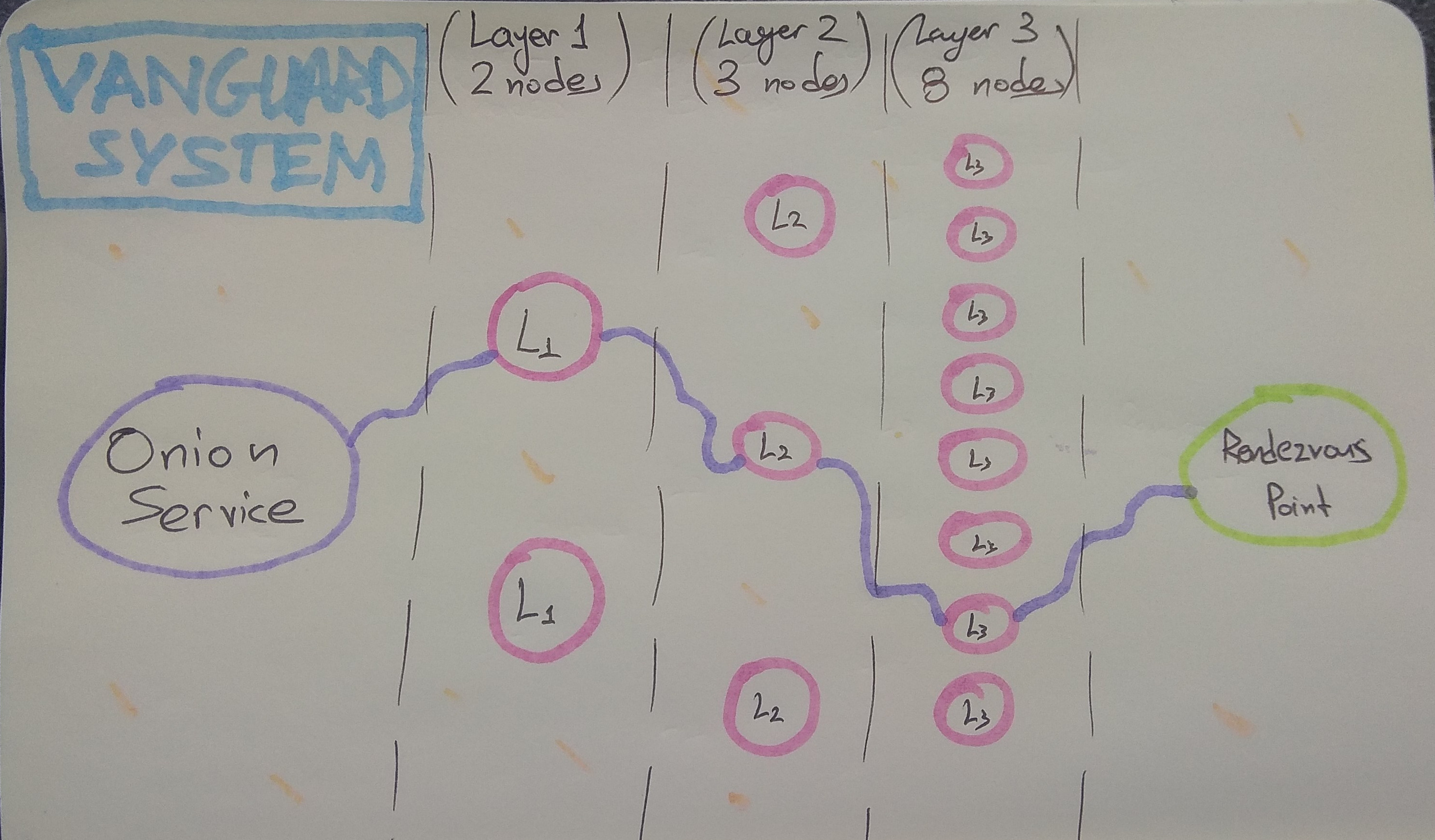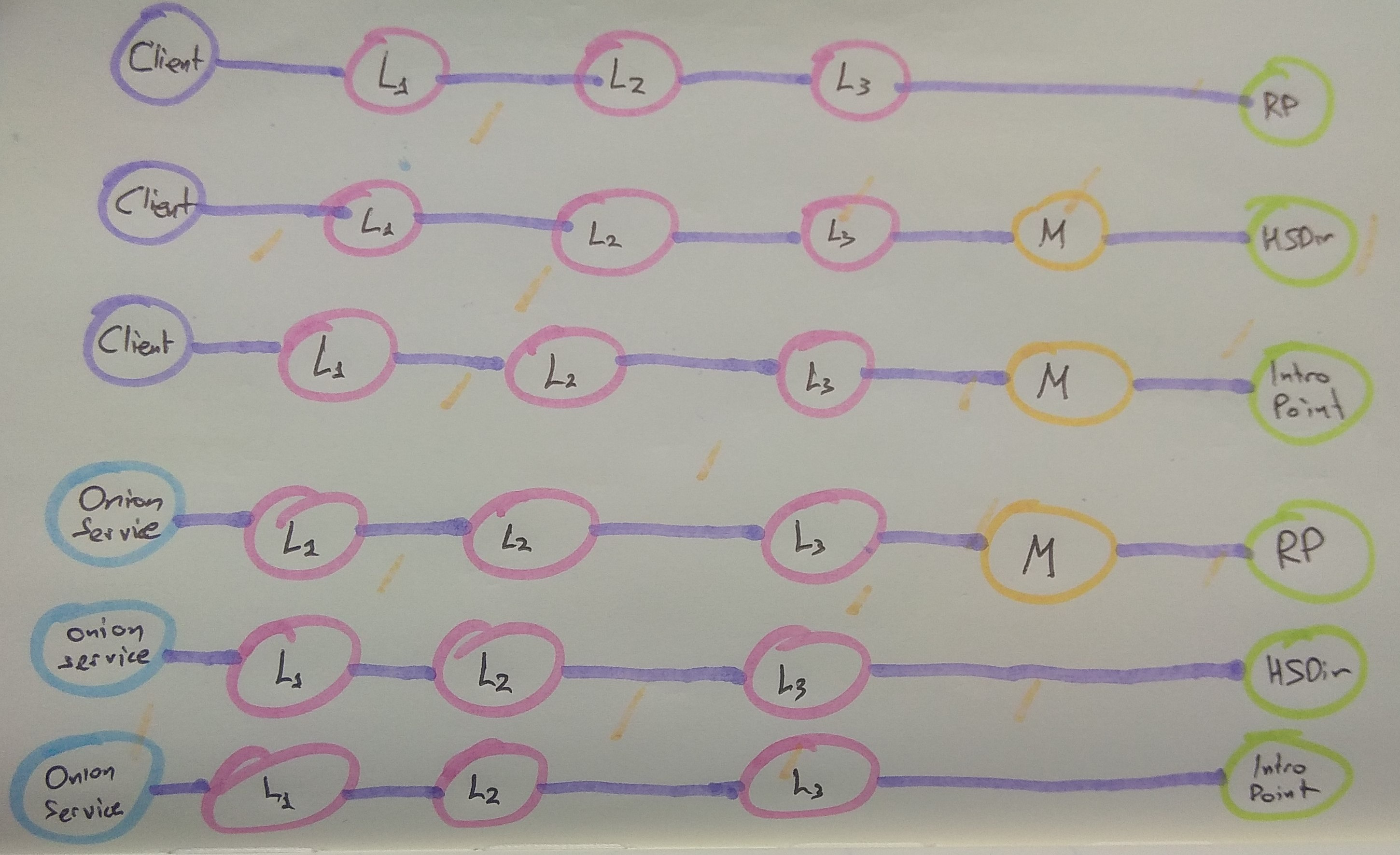This addon uses the Stem Tor control port library to connect to a Tor control port listening on port 9051 (or on an alternate user-specified port, or UNIX file system socket).
This addon protects against guard discovery and related traffic analysis attacks. A guard discovery attack enables an adversary to determine the guard node(s) that are in use by a Tor client and/or Tor onion service. Once the guard node is known, traffic analysis attacks that can deanonymize an onion service (or onion service user) become easier.
To understand these attacks as well as the rest of this document, first let's give a quick overview of how onion services work in Tor.
Onion service addresses are announced in encrypted descriptor documents which are uploaded to specially selected Tor relays, called HSDIRs. These descriptors list three Introduction Points, which are another set of relays that are used to make connection requests to a specific onion service.
Services create and hold open Introduction Circuits to their chosen Introduction Point relays, to accept connection requests from clients. These client connection requests specify a client-chosen relay called the Rendezvous Point, which the client has made a circuit to, to accept connection back from the service. When a service receives a request through their Introduction circuit, that service makes a separate Rendezvous circuit to connect to that client's chosen Rendezvous Point. Then, actual onion service application data flows over this Rendezvous circuit, as a Tor Stream.
The most basic form of the Guard discovery attack is to make many connections to a Tor onion service, in order to force it to create circuits until one of the adversary's relay is chosen for the middle hop next to the guard. That is possible because middle hops for rendezvous circuits are picked from the set of all relays:
This attack can also be performed against clients, by inducing them to create lots of connections to different onion services, by for example, injecting lots of onion-hosted images/elements into a page.
A traffic analysis side channel can be used to confirm that the malicious node is in fact part of the rendezvous circuit, leading to the discovery of that onion service's or client's guard node. From that point, the guard node can be compromised, coerced, or surveilled to determine the actual IP address of the onion service or client.
To defend against these attacks, this addon has three defense subsystems: Vanguards, Rendguard, and Bandguards.
All three subsystems apply to both service-side and client-side onion service activity. The Bandguards subsystem also applies to client traffic that exits the Tor network to the normal Internet.
The Vanguards subsystem uses the Tor control protocol to select nodes from the Tor consensus for use with the torrc options HSLayer2Nodes and HSLayer3Nodes.
Each of these options is assigned its own set of nodes, which are rotated based on the randomized selection algorithm specified in the Mesh Vanguards Proposal.
These options ensure that all onion service circuits are restricted to a set of second and third layer guards, instead of sampling random ones from the whole network every time.
The change to fixed nodes for the second and third layer guards is designed to force the adversary to have to run many more nodes, and to execute both an active sybil attack, as well as a node compromise attack. In particular, the addition of second layer guard nodes means that the adversary goes from being able to discover your guard in minutes by running just one middle node, to requiring them to sustain the attack for weeks or even months, even if they run 5% of the network.
The analysis behind our choice for the number of guards at each layer, and for rotation duration parameters is available on GitHub. Here is how our current vanguard 2-3-8 topology looks like:
Due to the risk of long-term information disclosure of interior guard layers, path restrictions have been disabled for onion service circuits built when vanguards are in use. This means that vanguards can be chosen from the same /16 subnet and node family as earlier hops in the circuit. Additionally, we also allow the same relay to be present in multiple positions in the path. These changes prevent an adversary from learning which relays are vanguards by creating many circuits and observing which relays are not chosen in the rendezvous endpoint position.
Furthermore, to better protect the identity of these new pinned guard nodes, and to avoid linkability of activity, the circuit lengths have been altered for rendezvous point circuits, hidden service directory circuits, and introduction point circuits. You can see them here (where L1 is the first layer guard, L2 is second layer guard, L3 is third layer guard, M is random middle):
The number of nodes in each of these sets, as well as the ranges on rotation times for each set, can be specified as config file parameters. The subsystem currently uses 2 entry guards, 4 layer2 guards, and 8 layer3 guards.
The Rendguard subsystem keeps track of how often various relays appear in the rendezvous point position on the service side of an onion service. Since rendezvous points are chosen by the client that connects to a service, it is possible for clients to choose malicious, colluding rendezvous points to help them mount guard discovery and other attacks.
This subsystem emits warnings and optionally closes the circuit when a rendezvous point is chosen too often compared to its consensus weight (the "too often" limit is set by the rend_use_max_use_to_bw_ratio config option, which defaults to 5X of a relay's consensus weight).
We assign an aggregate weight of rend_use_max_consensus_weight_churn (default: 1% of consensus total) for relays that are not in our current consensus that are used as rendezvous points. It is valid to use relays that are not in the consensus as rendezvous points, and this can happen naturally when a client's consensus is from a different time period as the service's consensus. To prevent arbitrary computers from being used as rendezvous points, we set this bound on the maximum amount of consensus churn, and use that to limit all rendezvous requests that are not present in the service's consensus.
When rendezvous points are overused and blocked by the addon, the effect is that clients get connection refused responses when they attempt to use rendezvous points that are already overused. Since the adversary gets to pick their rendezvous point, they can trigger these limits at will, and cause popular rendezvous points to be blocked by your service. If this happens, you can set rend_use_close_circuits_on_overuse to false in your configuration file. If you do this, rendezvous overuse messages will appear at WARN level, but circuits will not be closed.
If you experience false positives with this system, also consider raising rend_use_global_start_count and rend_use_relay_start_count. Please file a ticket if you have to change any of these options.
The bandguards subsystem performs accounting to watch for signs of bandwidth sidechannel attacks on individual onion service circuits as well as exit circuits. It then closes circuits that exceed these limits and emits log messages. While we expect the default values to be set properly, these limits can be tuned through configuration as well. See the configuration file for more details.
These limits (along with a reason for checking them) are as follows:
-
Dropped Cell Limit
Back in 2014, the Tor network was attacked by Carnegie Mellon researchers (likely on behalf of the FBI). The attack injected a side channel using a special packet type that could be recognized at both ends of a Tor circuit.
This side channel was fixed. Unfortunately, there are many other side channels available that allow an adversary to inject traffic that is ignored by a Tor client.
These remaining side channels are not as severe -- they cannot immediately be recognized by colluding relays using packet information alone. Instead the adversary must rely on packet volume and timing information in order to recognize the signal. However, if the volume of injected traffic is large enough or the cells are injected when traffic would not otherwise be sent, it may still be possible to use statistical methods to recover a signal. This class of attack is called DropMark, and it likely works in practice.
In fact, it may even be possible to inject so much dropped cell traffic that this causes a change in the public Guard relay bandwidth history or descriptor value, which allows Guard discovery.
The Bandguards component uses new control port features and improved connection tracking in Tor to measure the quantity of traffic that Tor decides to drop from a circuit, to protect against all such attacks that rely on dropped cells.
The allowed dropped cell count is 0, and cannot be configured.
Note that if your guard is malicious, it can ignore the DESTROY cell
-
Total Hidden Service Descriptor Kilobytes
In addition to injecting relay cells that are dropped, it is also possible for relays to inject data at the end of an onion service descriptor, or in response to an onion service descriptor submission. Tor will continue reading this data prior to attempting to parse the descriptor or response, and these parsers can be convinced to discard additional data.
The bandguards subsystem sets a limit on the total amount of traffic allowed on onion service descriptor circuits (currently 30 kilobytes). Once this limit is exceeded, the circuit is closed and a WARN log message is emitted by the bandguards subsystem.
If your service uses OnionBalance, or has set a large number of custom introduction points, you may need to raise this limit via the circ_max_hsdesc_kilobytes setting in the configuration file.
-
Total Service-Side Introduction Circuit Kilobytes
Introduction circuits are normally held open by services for ~18-24 hours, regardless of traffic quantity or activity, which makes them a risk for flood and check traffic analysis attacks. Additionally, introduction requests are a vector for denial of service, since they cause the service to spend considerably more resources to handle than they take to generate.
It turns out that closing introduction circuits after too many are sent can help with both of these cases. It does impact reachability, though, so this option should be used with care. It is off by default. (The long-term solution DoS solution is either Proof of Work or Introduction Tokens).
When circ_max_serv_intro_kilobytes is non-zero, the bandguards subsystem sets a limit on the total amount of traffic allowed on onion service introduction circuits. Once this limit is exceeded, the circuit is closed and a WARN log message is emitted by the bandguards subsystem.
-
Total Circuit Megabytes
A final vector for injecting side channel traffic is at the application layer.
If an attacker wants to introduce a side channel towards an onion service, they can fetch large quantities of data from that service, or make large HTTP posts towards the service, in order to generate detectable traffic patterns.
These traffic patterns can be detected in Tor's public relay bandwidth statistics, as well as via netflow connection volume records. The Tor Project is currently working on various mechanisms to reduce the granularity of these statistics (and has already reduced them to 24 hours of aggregate data), and has also deployed padding mechanisms to limit the resolution of netflow traffic logs, but it is not clear that these mechanisms are sufficient to obscure very large volumes of traffic.
Because of this, the bandguards subsystem has the ability to limit the total number of bytes sent over a circuit before a WARN is emitted and the circuit is closed. This limit is currently set to 0 (which means unlimited). If you know a reasonable bound for the amount of data your application or service should send on a circuit, be sure to set it to that value.
If your service or application depends upon the ability of people to make very very large transfers (such as OnionShare, or a SecureDrop instance), you should keep this disabled, or at best, set it to multiple gigabytes.
If your service is a normal website that does not transmit large content, 100 megabytes is a reasonable value for this setting.
We believe that using two entry guards makes closing the circuit a worthwhile defense for applications where it is possible to use it. If the adversary is forced to split their side channel across multiple circuits, they won't necessarily know which guard node each circuit traversed. This should increase the quantity of data they must inject in order to successfully mount this attack (and by more than just a factor of two, because of this uncertainty).
The traffic splitting done by Snowflake and the TurboTunnel prototype for obfs4 will also provide some degree of mitigation here.
Long-term, this feature is meant to be deployed in combination with conflux traffic splitting so that we can tear down one path of a circuit after over-use without loss of connectivity, and reconnect the remaining portion to a new circuit.
If you wish to enable this defense, change the value of circ_max_megabytes in the configuration file.
Additionally, if you notice this defense triggering, or other signs of unexpected high load or DoS attack, consider monitoring your Guard relay bandwidth in the public relay bandwidth data to check for noticable bumps in traffic that correspond to DoS, as this is a Guard discovery signal for the adversary. If you notice such bumps, please contact the Tor Project, as this means that our relay bandwidth reporting is too detailed.
-
Max Circuit Age
Since Tor currently rotates to new TLS connections every week, if a circuit stays open longer than this period, then it will cause its old TLS connection to be held open. After a while, the circuit will be one of the few things using that TLS connection. This lack of multiplexing makes traffic analysis easier.
For an example of an attack that makes use of this type of side channel, see TorScan. For additional discussion, see Tor Ticket #22728 and #23980.
For this reason, if your onion service does not require long-lived circuits, it is wise to close any that hang around for long enough to approach this rotation time.
The current default for maximum circuit age is 24 hours, and can be changed via circ_max_age_hours in the configuration file. It does not make much sense to make this value significantly lower (and low values such as 1 hour will make you stand out), but set it higher if you need long-lived connections to your service.
-
Connectivity to the Tor Network
Reachability itself is a side-channel. An adversary can correlate your uptime to other events to reduce your anonymity, or even actively attempt to influence connectivity to parts of the Tor network to determine if a specific service is using them. Because of this, we have added monitoring of connectivity to the Tor Network. The addon will alert you if all of your guard connections go down, or if you are unable to build circuits for a set amount of time.
Obviously, clients may want to disable this monitoring, especially if they are disconnected frequently. To disable these checks, change the circ_max_disconnected_secs and conn_max_disconnected_secs configuration settings to 0.
There are additional mitigation tips for this attack vector in README_SECURITY.md. In particular, the Snowflake pluggable transport and the TurboTunnel resumption prototype for obfs4 will mitigate the various forms of confirmation attacks of this side channel.
For additional security information, including attack vectors that remain against onion services and potential mitigations, please see README_SECURITY.md.



